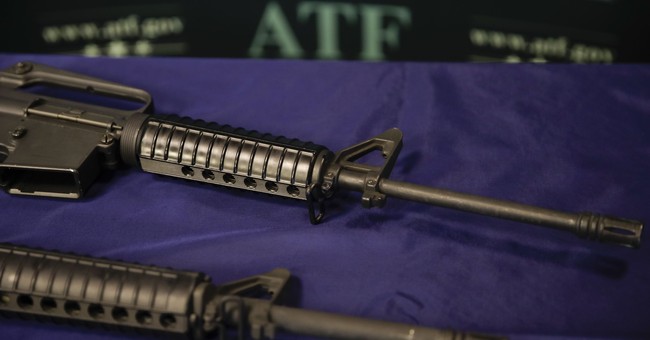
The ATF isn’t any gun owner’s favorite agency. There are a number of reasons for why this is true, including a long history of hyper-aggressive actions by its agents trying to enforce unconstitutional gun laws on the American people.
Who am I kidding, that’s mostly it.
And while I catch a lot of flak here for supporting the enforcement of laws that I generally disagree with and think are unconstitutional, there is a line even for me. Stuff like what is being suggested here, for example, is about a mile on the other side of it.
Although I cannot disclose all of the occasions where ATF has recently reversed its prior determinations or devised a new interpretation of the law or regulation, I can disclose a recent prosecution, of a veteran, where ATF devised a new interpretation out of whole cloth and was successful in convincing the U.S. Attorney’s Office for the Northern District of Ohio to prosecute. The case is U.S. v. Wright, 3:18-CR-162 and it should have the entire Firearms Community alarmed.
Although many of the documents have been sealed by the Court (that should tell you a good bit already), the superseding indictment is publicly available and suggests that Mr. Wright had an unregistered short-barrelled rifle (SBR) that was not registered in the National Firearms Registration and Transfer Record (NFRTR). Regardless of whether you believe the National Firearms Act is constitutional or appropriate, at the time of writing this article, the courts have not yet found it to be unconstitutional and if merely inappropriate, one’s proper recourse is to seek a statutory deletion or revision. Thus, the possession of an unregistered SBR is unlawful. So, why is this case concerning? Unfortunately most of the informative documents have been sealed…that is, except for the Government’s Motion in Limine. (For those who don’t know what a motion in limine is, it is a motion filed by a party which asks the court for an order or ruling limiting or preventing certain evidence from being presented during a trial).
When you review the Motion in Limine, you quickly learn that the Government is seeking to preclude ATF FATD (Firearms and Ammunition Technology Division) determinations from being used in any way during trial. These determinations appear to have been part of a discovery dispute, which is also sealed and is evidenced by the Government’s statement that “[t]he Government produced the letters under the protection of a protective order that the Court authorized on August 1, 2018.”. For the reasons that follow, I find it extremely comical that the Government actually contended that “ATF FATD letters at trial creates a grave risk of confusing the issues and misleading the jury,” but I digress…for now.
We quickly learn from the Government that:
The critical issue in this case will not be possession, registration (or lack thereof), or barrel length. Ultimately, the primary issue in dispute at trial will be whether or not Kelland Wright’s firearm meets the definition of a “rifle,” that is a firearm designed to be fired from the shoulder, see 26 U.S.C. § 5845(a). Part of this issue will center on the implications modifications that Kelland Wright made or had made to the firearm, including the addition of an extension piece to the rear of the firearm.
Hmmm, so now we know that the issue is whether the piece added to his Ar-15 pistol constituted a “stock” or not. The Government further contends:
Wright’s expert, Richard Vasquez, is expected to testify that the extension piece functions as a cheek rest. The Government’s expert, Firearms Enforcement Officer Eve E. Eisenbise, is expected to testify that the extension piece makes the firearm designed to be fired from the shoulder. Officer Eisenbise is an employee of the ATF FATD. Richard Vasquez formerly was employed by the FATD.
…
The relevant issues at trial relate to the specifics of Wright’s firearm, an AR pistol platform that was modified with an angled foregrip and collapsible stock.
Now, we’ve seen that the ATF has previously ruled that an extension piece doesn’t count as stock. The angled foregrip is in the same category.
So what gives?
Well, my interpretation based on the evidence presented is that the ATF determined that because the defendant used a collapsible arm brace, it counted as a collapsible stock and was somehow forbidden. There doesn’t seem to be any evidence that Mr. Wright even shouldered the weapon. It just decided to prosecute him.
And that’s where you lose me.
Every item on his weapon is one that is consistent with what the ATF has ruled previously and publicly. Now, however, it has decided it can change its mind on a whim and, with no warning, prosecute people for that undisclosed change of mind.
If that’s the case, something stinks to high heaven. At this point, anyone with an AR pistol equipped with an arm brace is subject to potential prosecution just because the ATF decides, “What the hell.”
It’s way past time that we take the power to essentially create law out of the hands of bureaucrats and place it back in the legislative branch’s hands as the Constitution intended. Even if this case isn’t what’s being presented here–and don’t get me wrong, I’m not saying that this is misrepresented in the least. I’m merely allowing for the possibility of either that or someone just being wrong–the fact that it’s even possible for this to happen should be troubling to every American.








Join the conversation as a VIP Member